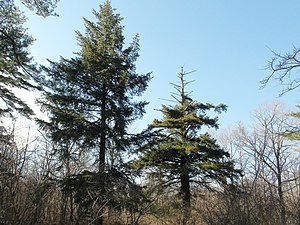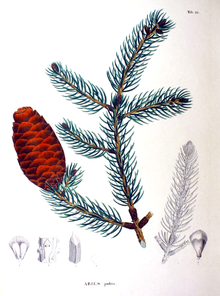Tiger-tail spruce
| Tiger-tail spruce | ||||||||||||
|---|---|---|---|---|---|---|---|---|---|---|---|---|

Tiger-tail spruce ( Picea torano ) |
||||||||||||
| Systematics | ||||||||||||
|
||||||||||||
| Scientific name | ||||||||||||
| Picea torano | ||||||||||||
| ( Siebold ex K. Koch ) Koehne |
The tiger-tail spruce ( Picea torano ) is a species of the genus Spruce ( Picea ) in the pine family (Pinaceae). It is native to Japan .
description
Vegetative characteristics
The tiger-tail spruce is an evergreen tree that can reach a height of up to 40 meters; the breast height diameter (BHD) can then be up to 1.5 meters. The bark is smooth when young; later it becomes rough, cracked, flaking off in scales with a gray-brown color. The habitus is monopodial and upright-columnar. First-order branches grow horizontally to slightly ascending; Second-order branches are short and dense. The branches are dense and appear yellowish-brown at first, then turn gray with age. The "leaf cushions" (Pulvini) are strongly developed and two to three millimeters long.
In the tiger-tail spruce, the only slightly resinous buds are elongated-egg-shaped and pointed or blunt; they can be up to 12 millimeters long and 8 millimeters wide. The bud scales are ovate, blunt, smooth and have a dark brown sheen; they remain as a scale-shaped, dark ring at the base of the long shoots. This characteristic is species-specific and can therefore be used for identification.
The needle-shaped leaves are spiraling on the branch. They have a glossy dark green color, are very stiff and can be up to 2 centimeters long and 2 millimeters wide. Along with those of Picea chihuahuana, the needles are probably the sharpest and most pointed of all spruce species.
Generative characteristics
Male cones are initially red and turn yellow when ripe in May / June and are then about 3 centimeters tall. The female, oval-egg-shaped cones are initially upright. When ripe in October, they can be up to 11 inches long and (with the scales open) about 7 inches wide. Their color is then reddish-brown. They release light brown, about 6 millimeters long and 3 millimeters wide, about 15 millimeters long winged seeds.
Occurrence
The tiger-tail spruce thrives at altitudes of 600 to 1700 meters on the Japanese islands of Honshū , Shikoku and Kyūshū ; the distribution area is only sparsely populated.
Almost without exception, the tiger-tail spruce grows on podsol soils of volcanic rock. There is a cool and humid maritime climate with an average annual rainfall of 1000 millimeters. The winters are cold and snowy, especially at higher altitudes. Some small remaining areas of pure stands still exist, otherwise the tiger-tail spruce forms with Abies homolepis , Japanese larch ( Larix kaempferi ) and Japanese red pine ( Pinus densiflora ) as well as with birch ( Betula ), beech ( Fagus ) and maple species ( Acer spec.) Mixed stocks.
Systematics
The basionym Abies torano Siebold ex K. Koch was published in 1873 by Philipp Franz von Siebold and Karl Heinrich Koch in Dendrologie , 2, 2, p. 233. For a long time Picea polita (Siebold et Zucc.) Carrière was the valid botanical name for the tiger-tail spruce. However, since the underlying basionym Abies polita was already in use as an illegitimate renaming of Pinus abies L. or Picea abies (L.) H. Karsten , the epithet polita may not be used here. Instead, the description under the name Abies torano von Siebold was used, which in turn referred to the description given by Karl Heinrich Koch in his work Dendrology . The German botanist Bernhard Adalbert Emil Koehne referred to Siebold's description in his work Deutsche Dendrologie 22 published in 1893 and placed this species in the genus of the spruce ( Picea ). This is how the accepted botanical name Picea torano (Siebold ex K. Koch) Koehne results .
Synonyms for Picea torano (Siebold ex K.Koch) Koehne are: Abies polita Siebold et Zucc. nom. illegal. , Abies torano Siebold ex K.Koch , Picea polita (Siebold et Zucc.) Carrière , Pinus polita (Siebold et Zucc.) Antoine , Pinus torano (Siebold ex K.Koch) Voss .
literature
- Aljos Farjon: Pinaceae: drawings and descriptions of the genera Abies, Cedrus, Pseudolarix, Keteleeria, Nothotsuga, Tsuga, Cathaya, Pseudotsuga, Larix and Picea . Koeltz Scientific Books, Königstein 1990, ISBN 3-87429-298-3 .
- Christopher J. Earle: Picea torano. In: The Gymnosperm Database. January 20, 2011, accessed October 23, 2011 .
- Liguo Fu, Nan Li, Thomas S. Elias, Robert R. Mill: Picea torano . In: Wu Zheng-yi, Peter H. Raven (Ed.): Flora of China . Volume 4: Cycadaceae through Fagaceae . Science Press / Missouri Botanical Garden Press, Beijing / St. Louis 1999, ISBN 0-915279-70-3 , pp. 32 (English).
Single references
- ↑ Picea torano at Tropicos.org. Missouri Botanical Garden, St. Louis, accessed April 15, 2019.
- ^ Liguo Fu, Nan Li, Thomas S. Elias, Robert R. Mill: Pinaceae. : Picea torano (Siebold ex K. Koch) Koehne , p. 32 - online with the same text as the printed work , In: Wu Zheng-yi, Peter H. Raven (Ed.): Flora of China. Volume 4: Cycadaceae through Fagaceae. Science Press and Missouri Botanical Garden Press, Beijing and St. Louis, 1999, ISBN 0-915279-70-3 .
- ↑ a b Christopher J. Earle: Picea torano In: The Gymnosperm Database , 2019.
Web links
- Picea torano inthe IUCN 2013 Red List of Threatened Species . Listed by: T. Katsuki, A. Farjon, 2010. Retrieved April 15, 2019.


